
Concept explainers
Refer to the color scheme given Figure 3-3, and give the molecular formulas for molecules whose ball-and-stick models are given here.
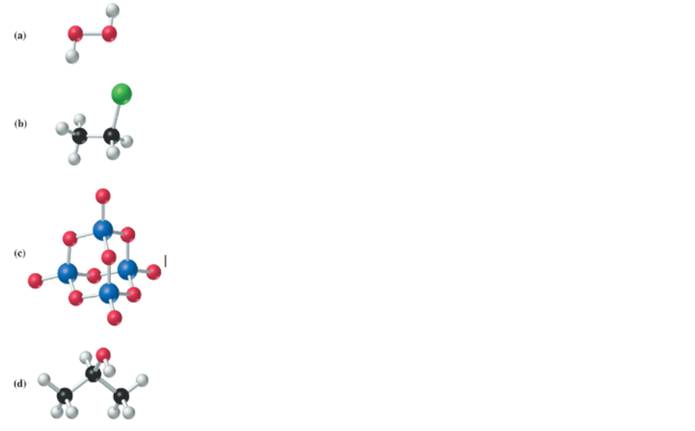
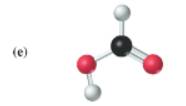
(a)
Interpretation:
The molecular formula for the given ball and stick model of the molecule needs to be determined.

Concept introduction:
The ball and stick model of a chemical substance is defined as a molecular model that displays the 3-D position of the atoms and bonds present between them. In the ball and stick model, the atoms are represented as balls or sphere where different atoms are shown by different colors and bonds are represented by sticks drawn between the atoms. The double and triple bonds are shown by drawing 2 and 3 sticks (curved rod) respectively between the atoms.
Answer to Problem 1E
Explanation of Solution
The given structure is as follows:

According to the color scheme given in figure 3.3 in the book, oxygen atom is represented by red sphere and hydrogen atom by white sphere. Thus, there are 2 oxygen atoms bonded together with single bond and 1 hydrogen atom each.
The molecular formula of the molecule will be
(b)
Interpretation:
The molecular formula for the given ball and stick model of the molecule needs to be determined.

Concept introduction:
The ball and stick model of a chemical substance is defined as a molecular model that displays the 3-D position of the atoms and bonds present between them. In the ball and stick model, the atoms are represented as balls or sphere where different atoms are shown by different colors and bonds are represented by sticks drawn between the atoms. The double and triple bonds are shown by drawing 2 and 3 sticks (curved rod) respectively between the atoms.
Answer to Problem 1E
Explanation of Solution
The given structure is as follows:

According to the color scheme given in figure 3.3 in the book, carbon atom is represented by black sphere, hydrogen atom by white sphere and chlorine atom by dark green sphere. Thus, there are 2 carbon atoms bonded together. One carbon atom is bonded with 3 hydrogen atoms and other with 2 hydrogen atoms and 1 chlorine atom.
The molecular formula of the molecule will be
(c)
Interpretation:
The molecular formula for the given ball and stick model of the molecule needs to be determined.
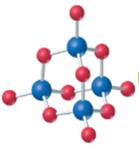
Concept introduction:
The ball and stick model of a chemical substance is defined as a molecular model that displays the 3-D position of the atoms and bonds present between them. In the ball and stick model, the atoms are represented as balls or sphere where different atoms are shown by different colors and bonds are represented by sticks drawn between the atoms. The double and triple bonds are shown by drawing 2 and 3 sticks (curved rod) respectively between the atoms.
Answer to Problem 1E
Explanation of Solution
The given structure is as follows:
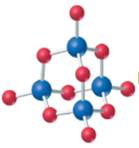
According to the color scheme given in figure 3.3 in the book, phosphorus atom is represented by dark blue sphere and oxygen atom with red sphere. Thus, there are 4 phosphorus atoms and 10 oxygen atoms. The molecular formula of the molecule will be
(d)
Interpretation:
The molecular formula for the given ball and stick model of the molecule needs to be determined.

Concept introduction:
The ball and stick model of a chemical substance is defined as a molecular model that displays the 3-D position of the atoms and bonds present between them. In the ball and stick model, the atoms are represented as balls or sphere where different atoms are shown by different colors and bonds are represented by sticks drawn between the atoms. The double and triple bonds are shown by drawing 2 and 3 sticks (curved rod) respectively between the atoms.
Answer to Problem 1E
Explanation of Solution
The given structure is as follows:

According to the color scheme given in figure 3.3 in the book, carbon atom is represented by black sphere, hydrogen atom by white sphere and oxygen atom by red sphere. Thus, there are 3 carbon atoms. The 2 carbon atoms are attached with 3 hydrogen atoms each and 1 carbon atom is attached with 2 hydrogen atoms and 1oxygen atom. The molecular formula of the molecule will be
(e)
Interpretation:
The molecular formula for the given ball and stick model of the molecule needs to be determined.
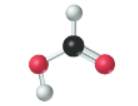 Concept introduction:
Concept introduction:
The ball and stick model of a chemical substance is defined as a molecular model that displays the 3-D position of the atoms and bonds present between them. In the ball and stick model, the atoms are represented as balls or sphere where different atoms are shown by different colors and bonds are represented by sticks drawn between the atoms. The double and triple bonds are shown by drawing 2 and 3 sticks (curved rod) respectively between the atoms.
Answer to Problem 1E
Explanation of Solution
The given molecule is as follows:
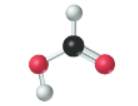
According to the color scheme given in figure 3.3 in the book, carbon atom is represented by black sphere, hydrogen atom by white sphere and oxygen atom by red sphere. The 2 curved rods between 1 carbon and 1 oxygen atom represents the double bond. Thus, there is 1 carbon atom bonded with 1 oxygen atom via double bond, 1 hydrogen atom via single bonds and 1 oxygen atom via single bond which is further attached with another hydrogen atom. The molecular formula of the molecule will be
Want to see more full solutions like this?
Chapter 3 Solutions
GENERAL CHEMISTRY(LL)-W/MASTERINGCHEM.
Additional Science Textbook Solutions
Brock Biology of Microorganisms (15th Edition)
HUMAN ANATOMY
Laboratory Experiments in Microbiology (12th Edition) (What's New in Microbiology)
Organic Chemistry
Human Biology: Concepts and Current Issues (8th Edition)
General, Organic, and Biological Chemistry - 4th edition
- Provide the structure, circle or draw, of the monomeric unit found in the biological polymeric materials given below. HO OH amylose OH OH 행 3 HO cellulose OH OH OH Ho HOarrow_forwardWhat units (if any) does K have? Does K depend upon how the concentration is expressed (e.g. molarity, ppm, ppb, etc.)? in calculating the response factorarrow_forwardDon't used hand raiting and don't used Ai solutionarrow_forward
- Don't used Ai solution and don't used hand raitingarrow_forwardOA. For the structure shown, rank the bond lengths (labeled a, b and c) from shortest to longest. Place your answer in the box. Only the answer in the box will be graded. (2 points) H -CH3 THe b Нarrow_forwardDon't used hand raitingarrow_forward
- Quizzes - Gen Organic & Biological Che... ☆ myd21.lcc.edu + O G screenshot on mac - Google Search savings hulu youtube google disney+ HBO zlib Homework Hel...s | bartleby cell bio book Yuzu Reader: Chemistry G periodic table - Google Search b Home | bartleby 0:33:26 remaining CHEM 120 Chapter 5_Quiz 3 Page 1: 1 > 2 > 3 > 6 ¦ 5 > 4 > 7 ¦ 1 1 10 8 ¦ 9 a ¦ -- Quiz Information silicon-27 A doctor gives a patient 0.01 mC i of beta radiation. How many beta particles would the patient receive in I minute? (1 Ci = 3.7 x 10 10 d/s) Question 5 (1 point) Saved Listen 2.22 x 107 222 x 108 3.7 x 108 2.22 x 108 none of the above Question 6 (1 point) Listen The recommended dosage of 1-131 for a test is 4.2 μCi per kg of body mass. How many millicuries should be given to a 55 kg patient? (1 mCi = 1000 μСi)? 230 mCiarrow_forwardDon't used hand raiting and don't used Ai solutionarrow_forwardDon't used hand raiting and don't used Ai solutionarrow_forward
- Q3: Arrange each group of compounds from fastest SN2 reaction rate to slowest SN2 reaction rate. CI Cl H3C-Cl CI a) A B C D Br Br b) A B C Br H3C-Br Darrow_forwardQ4: Rank the relative nucleophilicity of halide ions in water solution and DMF solution, respectively. F CI Br | Q5: Determine which of the substrates will and will not react with NaSCH3 in an SN2 reaction to have a reasonable yield of product. NH2 Br Br Br .OH Brarrow_forwardClassify each molecule as optically active or inactive. Determine the configuration at each H соон Chirality center OH 애 He OH H3C Ноос H H COOH A K B.arrow_forward
 Chemistry: The Molecular ScienceChemistryISBN:9781285199047Author:John W. Moore, Conrad L. StanitskiPublisher:Cengage Learning
Chemistry: The Molecular ScienceChemistryISBN:9781285199047Author:John W. Moore, Conrad L. StanitskiPublisher:Cengage Learning Introduction to General, Organic and BiochemistryChemistryISBN:9781285869759Author:Frederick A. Bettelheim, William H. Brown, Mary K. Campbell, Shawn O. Farrell, Omar TorresPublisher:Cengage Learning
Introduction to General, Organic and BiochemistryChemistryISBN:9781285869759Author:Frederick A. Bettelheim, William H. Brown, Mary K. Campbell, Shawn O. Farrell, Omar TorresPublisher:Cengage Learning Chemistry for Today: General, Organic, and Bioche...ChemistryISBN:9781305960060Author:Spencer L. Seager, Michael R. Slabaugh, Maren S. HansenPublisher:Cengage Learning
Chemistry for Today: General, Organic, and Bioche...ChemistryISBN:9781305960060Author:Spencer L. Seager, Michael R. Slabaugh, Maren S. HansenPublisher:Cengage Learning


